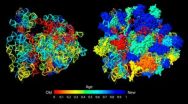(Press-News.org) Los Angeles, March 12, 2012 – Cedars-Sinai researchers have unlocked the mystery of how an inflammatory molecule is produced in the body, a discovery they say could lead to advances in the treatment of rheumatoid arthritis, Type 2 diabetes and numerous other chronic diseases that affect tens of millions of people.
The study, funded by the National Institutes of Health, is published online by the peer-reviewed journal Immunity and will appear in the March print edition.
The researchers identified for the first time the mechanism that leads to the production of the molecule interleukin-1beta. It is a major contributor to inflammation, which lies at the root of many serious health conditions, including atherosclerotic heart disease and some types of strokes.
Current drug therapies seek to block this molecule's action after it is secreted by cells. However, the new research could lead to the development of treatments that would prevent the body from producing it, resulting in more effective medications and therapies for inflammatory diseases.
"If we understand how this molecule is made in the body, we may be able to block it before it is produced," said study author Dr. Moshe Arditi, executive vice chair of research in the Department of Pediatrics and director of the Division of Pediatric Infectious Diseases and Immunology. "Until now, this was the missing piece of the puzzle."
Arditi, who also directs Cedars-Sinai's Infectious and Immunologic Diseases Research Center, found that damaged mitochondrial DNA activate specific proteins within dying cells, triggering the release of interleukin-1beta. Previous research has shown the molecule, when over-secreted by cells, can be a significant contributor to major inflammatory diseases.
Three of these diseases alone -- atherosclerosis, Type 2 diabetes and rheumatoid arthritis – affect an estimated 100 million Americans.
Arditi is planning further studies to build on the findings.
"The discovery by Arditi and colleagues has great potential to impact a wide range of inflammatory diseases, particularly in their early stages where an intervention could prevent more severe and debilitating ravages of such diseases," said Dr. Leon Fine, Cedars-Sinai's vice dean of research and chair of biomedical sciences. "This discovery, at last, may open the door to such therapy."
In addition to Cedars-Sinai, other research groups involved in the study include UCLA 's David Geffen School of Medicine, UC Merced's Health Sciences Research Institute and School of Natural Sciences; UC Riverside's Department of Chemistry and the University of Massachusetts Medical School's Department of Medicine.
###
END
CHAMPAIGN, Ill. — In the beginning – of the ribosome, the cell's protein-building workbench – there were ribonucleic acids, the molecules we call RNA that today perform a host of vital functions in cells. And according to a new analysis, even before the ribosome's many working parts were recruited for protein synthesis, proteins also were on the scene and interacting with RNA. This finding challenges a long-held hypothesis about the early evolution of life.
The study appears in the journal PLoS ONE.
The "RNA world" hypothesis, first promoted in 1986 in a paper in the ...
AUDIO:
This is an audio recording of the distinctive "ribbit " call of the Pacific chorus frog (28 seconds long, MP3 file, WAV file available on request).
This noisy frog is a potent...
Click here for more information.
Known for its distinctive "ribbit" call, the noisy Pacific chorus frog is a potent carrier of a deadly amphibian disease, according to new research published today in the journal PLoS ONE. Just how this common North American frog survives chytridiomycosis ...
Four articles in the current issue draw attention to policy initiatives and implications of the rapidly changing U.S. health care environment. Collectively, they examine some of the challenges and opportunities facing the country following the 2010 passage of the Patient Protection and Affordable Care Act.
Researchers Project Cost of Family Health Insurance Premiums Will Surpass Household Income by 2033
Updating estimates of who will be able to afford health insurance in the future in light of the 2010 Patient Protection and Affordable Care Act that reformed health ...
Using injectable diacetylmorphine — the active ingredient in heroin — to treat chronic opioid addiction is cheaper and more effective than methadone, states an article in CMAJ (Canadian Medical Association Journal).
Methadone is the most common treatment for people who are dependent on opioids such as heroin, although research indicates that most people over time go back to using illicit drugs. The North American Opiate Medication Initiative, a randomized controlled trial, indicated that diacetylmorphine is more effective in keeping opioid-dependent people in treatment. ...
A 21,626-person study published today in the Journal of Clinical Oncology found that the five-year survival rate for children and adolescents with acute lymphoblastic leukemia (ALL), the most common childhood cancer, improved from 83.7 percent in those diagnosed during the years 1990-1994, to 90.4 percent for those diagnosed in the years 2000-2005.
"The improved survival is due to using existing drugs better, not because of the introduction of new drugs. We're indebted to all the families who choose to join these clinical trials, allowing us to optimize these combinations," ...
PHILADELPHIA (March 12, 2012) – Scientists from the Monell Center report that seven of 12 related mammalian species have lost the sense of sweet taste. As each of the sweet-blind species eats only meat, the findings demonstrate that a liking for sweets is frequently lost during the evolution of diet specialization.
Previous research from the Monell team had revealed the remarkable finding that both domestic and wild cats are unable to taste sweet compounds due to defects in a gene that controls structure of the sweet taste receptor.
Cats are obligate carnivores, meaning ...
Medically prescribed heroin is more cost-effective than methadone for treating long-term street heroin users, according to a new study by researchers at Providence Health Care and the University of British Columbia.
The study, published today in the Canadian Medical Association Journal (CMAJ), attributed most of the economic benefits to the fact that recipients of medically prescribed heroin (diacetylmorphine) stayed in treatment longer and spent less time in relapse than those receiving methadone. Both results are associated with reduced criminal activity and lower health ...
The diagnosis of localized bladder cancer carries an 80 percent five-year survival rate, but once the cancer spreads, the survival rate at even three years is only 20 percent. A major study published today in the Journal of Clinical Investigation not only shows how bladder cancer metastasizes to the lungs but pinpoints a method for stopping this spread.
Specifically, the study shows that versican, a protein involved in cancer cell migration, is a driver of lung metastasis and that high levels of versican are associated with poor prognosis in bladder cancer patients. The ...
EDITOR'S PICK
Restoring what's lost: uncovering how liver tissue regenerates
The liver is unique among mammalian organs in its ability to regenerate after significant tissue damage or even partial surgical removal. Laurie DeLeve and her colleagues at the University of Southern California in Los Angeles wanted to better understand which cells are specifically responsible for driving liver regeneration. A specialized cell type, known as liver sinusoidal endothelial cells, has generally been thought to promote regeneration of liver tissue. However, the DeLeve team suspected ...
Granite countertops in Atlanta have a lot of competition these days with the popularity of concrete, recycled glass, soapstone, quartz, and a host of other surfaces gaining ground in the Atlanta countertops market. However, Craftmark Countertops in Atlanta points out that the look and longevity of Atlanta granite countertops is comparable to the other surfaces and often a fraction of the cost.
With its rise in popularity over the last decade, granite is no longer a surface of exclusivity, and so some higher end homes are being built with other more expensive surfaces. ...

